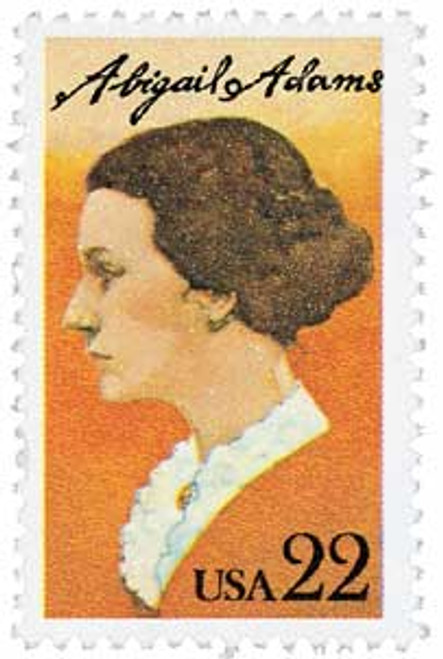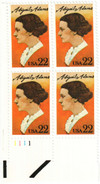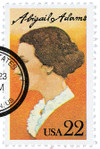
# 2146 - 1985 22c Abigail Adams
U.S. #2146
1985 22¢ Abigail Adams
- Fourth US First Lady on a US postage stamp
- Honored because of her prolific correspondence with her husband, President John Adams, totaling more than 2,000 letters
Stamp Category: Commemorative
Value: 22¢; first-class rate
First Day of Issue: June 14, 1985
First Day City: Quincy, Massachusetts
Quantity Issued: 126,325,000
Printed by: Bureau of Engraving and Printing
Printing Method: Photogravure
Format: Panes of 50 in sheets of 200
Perforations: 11
Why the stamp was issued: To honor First Lady Abigail Adams, whose been called “America’s first emancipated woman.” This stamp’s issue didn’t coincide with any notable anniversary, rather it honored Adams because she was a “prolific letter writer and user of the mails throughout her life.” Abigail and John’s extensive letter writing was featured on a series of Love stamps in 2001 – US #3496//3551.
About the stamp design: No photographic images of Abigail exist, so stamp designer Bart Forbes based him stamp portrait on a variety of paintings, engravings, and paper silhouettes.
First Day City: This stamp was issued in Quincy, Massachusetts, where Abigail managed the Adams estate and spent most of her life.
Unusual fact about the stamp: Imperforate error pairs have been discovered.
History the stamp represents: America’s second First Lady was born Abigail Smith on November 22, 1744 (November 11 in the Old Style calendar), in Weymouth, Massachusetts.
Much to Abigail’s regret, she never received formal schooling. Fortunately, she was raised in a home filled with the libraries of her father, grandfather, and also intelligent conversation. She learned to read and write, showing special interests in philosophy, theology, Shakespeare, the classics, ancient history, government, and law. Abigail was an avid history reader and recognized its importance and impact on her own life and surroundings.
In 1759, Abigail met a lawyer named John Adams. Within three years, the pair were writing love letters to each other. John called Abigail “Miss Adorable” and Abigail called John “Dearest Friend.” They were married on October 25, 1764, by her father, the Reverend Smith. Immediately following the wedding, the couple moved into a small cottage next to John’s childhood home.
In 1774, John Adams went to Philadelphia to serve as the Massachusetts delegate in the Continental Congress. This began a new series of letters between them, chronicling the Revolutionary and Federal eras and the public issues debated by America’s new leaders. Many of these letters recount Abigail’s advice to her husband and her observations of the press and citizens’ reactions to news of the American Revolution. They also detail her struggles with wartime shortages and inflation, challenges of raising five children and running a farm, and most of all, her loneliness without her husband.
When her husband was appointed to a diplomatic mission to Paris in 1784, Abigail joined him, along with their son, future President John Quincy, and daughter Nabby. She closely observed French manners and court, knowledge she would later put to use as First Lady. The following year, John was made America’s first Minister to Great Britain, where Abigail earned a reputation for dignity and tact. In 1788, the family returned home to Braintree (now Quincy), Massachusetts, to their home known as “Old House,” which Abigail spent a great deal of time and energy remodeling and enlarging.
In 1789, Abigail became the first Second Lady of the United States, when her husband was elected Vice President of the United States. She developed a close relationship with First Lady Martha Washington, who often called on Abigail for assistance in entertaining, recalling her experiences in the courts and societies of Europe.
Following eight years as Vice President, John Adams was elected President of the United States in 1797. Abigail continued her formal entertaining and was the first hostess of the White House while it was still under construction. Abigail was also very active in politics and policy, earning her the nickname “Mrs. President.”
Abigail often wrote editorial letters in attempts to help her husband’s administration and spread the word about important events and policies. Two issues that were most important to her were women’s rights and slavery. As early as the 1770s, Abigail was an adamant supporter of women’s rights to equality. She believed that women deserved many of the same rights as men, and that they shouldn’t be expected to follow laws that weren’t written for them. She believed above all that women deserved to be educated and should have the same legal status as men. She was also adamantly against slavery. She believed it was not only evil, but dangerous to the American democracy.
In March 1801, following the loss of re-election to former family friend Thomas Jefferson, John and Abigail returned to their Braintree home. At first, Adams and Jefferson lost contact over political beliefs, but following the death of Jefferson’s daughter, Abigail wrote to the President, renewing their friendship. Abigail proudly followed her son John Quincy’s political career, but never got to see him serve as President. On October 28, 1818, Abigail died of typhoid fever. Her last words were, “Do not grieve, my friend, my dearest friend. I am ready to go. And John, it will not be long.”
U.S. #2146
1985 22¢ Abigail Adams
- Fourth US First Lady on a US postage stamp
- Honored because of her prolific correspondence with her husband, President John Adams, totaling more than 2,000 letters
Stamp Category: Commemorative
Value: 22¢; first-class rate
First Day of Issue: June 14, 1985
First Day City: Quincy, Massachusetts
Quantity Issued: 126,325,000
Printed by: Bureau of Engraving and Printing
Printing Method: Photogravure
Format: Panes of 50 in sheets of 200
Perforations: 11
Why the stamp was issued: To honor First Lady Abigail Adams, whose been called “America’s first emancipated woman.” This stamp’s issue didn’t coincide with any notable anniversary, rather it honored Adams because she was a “prolific letter writer and user of the mails throughout her life.” Abigail and John’s extensive letter writing was featured on a series of Love stamps in 2001 – US #3496//3551.
About the stamp design: No photographic images of Abigail exist, so stamp designer Bart Forbes based him stamp portrait on a variety of paintings, engravings, and paper silhouettes.
First Day City: This stamp was issued in Quincy, Massachusetts, where Abigail managed the Adams estate and spent most of her life.
Unusual fact about the stamp: Imperforate error pairs have been discovered.
History the stamp represents: America’s second First Lady was born Abigail Smith on November 22, 1744 (November 11 in the Old Style calendar), in Weymouth, Massachusetts.
Much to Abigail’s regret, she never received formal schooling. Fortunately, she was raised in a home filled with the libraries of her father, grandfather, and also intelligent conversation. She learned to read and write, showing special interests in philosophy, theology, Shakespeare, the classics, ancient history, government, and law. Abigail was an avid history reader and recognized its importance and impact on her own life and surroundings.
In 1759, Abigail met a lawyer named John Adams. Within three years, the pair were writing love letters to each other. John called Abigail “Miss Adorable” and Abigail called John “Dearest Friend.” They were married on October 25, 1764, by her father, the Reverend Smith. Immediately following the wedding, the couple moved into a small cottage next to John’s childhood home.
In 1774, John Adams went to Philadelphia to serve as the Massachusetts delegate in the Continental Congress. This began a new series of letters between them, chronicling the Revolutionary and Federal eras and the public issues debated by America’s new leaders. Many of these letters recount Abigail’s advice to her husband and her observations of the press and citizens’ reactions to news of the American Revolution. They also detail her struggles with wartime shortages and inflation, challenges of raising five children and running a farm, and most of all, her loneliness without her husband.
When her husband was appointed to a diplomatic mission to Paris in 1784, Abigail joined him, along with their son, future President John Quincy, and daughter Nabby. She closely observed French manners and court, knowledge she would later put to use as First Lady. The following year, John was made America’s first Minister to Great Britain, where Abigail earned a reputation for dignity and tact. In 1788, the family returned home to Braintree (now Quincy), Massachusetts, to their home known as “Old House,” which Abigail spent a great deal of time and energy remodeling and enlarging.
In 1789, Abigail became the first Second Lady of the United States, when her husband was elected Vice President of the United States. She developed a close relationship with First Lady Martha Washington, who often called on Abigail for assistance in entertaining, recalling her experiences in the courts and societies of Europe.
Following eight years as Vice President, John Adams was elected President of the United States in 1797. Abigail continued her formal entertaining and was the first hostess of the White House while it was still under construction. Abigail was also very active in politics and policy, earning her the nickname “Mrs. President.”
Abigail often wrote editorial letters in attempts to help her husband’s administration and spread the word about important events and policies. Two issues that were most important to her were women’s rights and slavery. As early as the 1770s, Abigail was an adamant supporter of women’s rights to equality. She believed that women deserved many of the same rights as men, and that they shouldn’t be expected to follow laws that weren’t written for them. She believed above all that women deserved to be educated and should have the same legal status as men. She was also adamantly against slavery. She believed it was not only evil, but dangerous to the American democracy.
In March 1801, following the loss of re-election to former family friend Thomas Jefferson, John and Abigail returned to their Braintree home. At first, Adams and Jefferson lost contact over political beliefs, but following the death of Jefferson’s daughter, Abigail wrote to the President, renewing their friendship. Abigail proudly followed her son John Quincy’s political career, but never got to see him serve as President. On October 28, 1818, Abigail died of typhoid fever. Her last words were, “Do not grieve, my friend, my dearest friend. I am ready to go. And John, it will not be long.”









